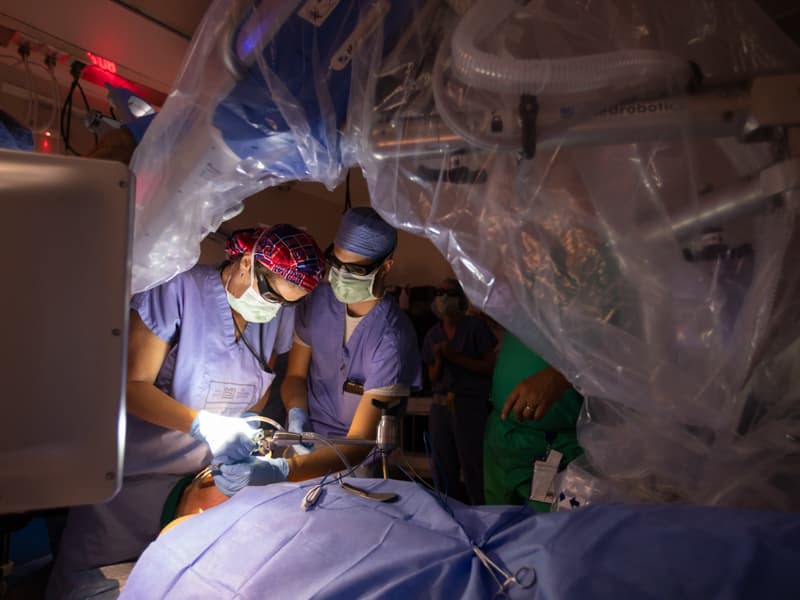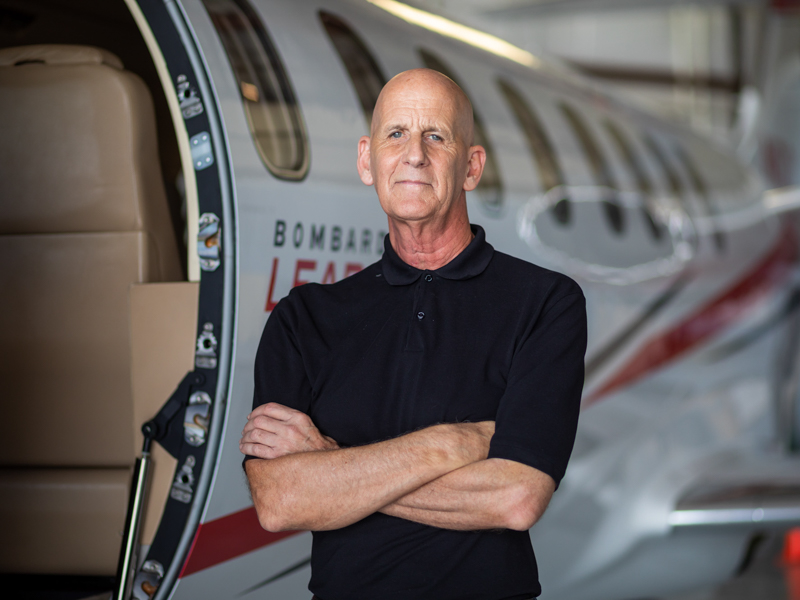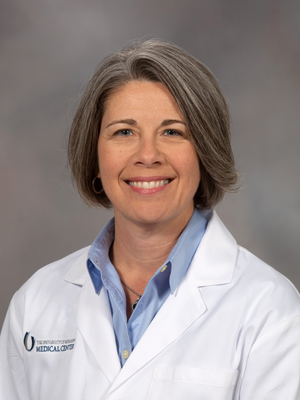Robotic device gives surgeons more flexibility to treat head, neck cancers

Painful throat problems have been Greg Meadows’ lifelong nemesis.
“You say the word strep, and I’d get it,” said Meadows, a Laurel resident and corporate jet pilot. “Whenever I got sick, it would settle in my throat.”
So when his throat turned red and swallowing became difficult in January 2019, it was an irritation but not a big concern. Meadows’ general practitioner diagnosed it as post-nasal drip and gave him an over-the-counter allergy medicine that made him feel better.
“But I still had a tickle in the back of my throat when I swallowed,” Meadows remembered. “It would come and go, and I kind of forgot about it.”

In May, he noticed a lump forming on the side of his neck. His general practitioner referred him to an ENT, who biopsied lymph glands in his neck and ordered a CT scan. The biopsy was inconclusive, Meadows said, but the scan showed thickening of his throat.
His doctor referred him to UMMC’s Dr. Gina Jefferson, associate professor of otolaryngology and communicative sciences. “I went there a week and a half later,” Meadows said. Jefferson biopsied his throat; it was squamous cell carcinoma, an often aggressive cancer that is best and most easily removed in its early stages.
Surgeons typically cut through the jaw line to reach the tumors in the “gutters” of the throat, dividing muscles that help you swallow and putting into jeopardy the function of nerves on each side of the tongue.
Jefferson instead performed a minimally invasive procedure: flexible robotic surgery, in which surgeons approach the tumor through a patient’s mouth rather than the more traumatic step of splitting open his jaw. UMMC is the only facility in the state offering the procedure, says the instrument’s maker, Medrobotics.

If a patient’s disease state, including size of tumor and its location, makes them a flexible robotic surgery candidate, “it’s important for them to have that option,” Jefferson said. “The reason we offer this surgery is so that the patient potentially has just one type of treatment, while preserving their function.”
How it works: The robotic system allows surgeons access to anatomical locations - for example, the throat - that were previously difficult or impossible to reach in a minimally invasive manner.
Surgeons guide a flexible scope, not a traditional straight scope, through a patient’s mouth toward the tumor. Using 3D technology, they get a clear view of the path to the surgical site. Then, they pass small, flexible surgical instruments through the scope and use them to cut out the cancerous area.
Meadows’ surgery was June 20. He went home the next day.
“She said robotics, and I didn’t think too much about it until I started reading about it,” Meadows said of his preparation for surgery. “The benefits were pretty astounding. She warned me that I would have the mother of all sore throats afterward, but that was about it. The pain subsided pretty quickly, and I was off pain meds in four days.
“They removed 46 lymph nodes,” requiring a seven-inch incision, he said. To ensure all cancer cells were gone, Meadows’ medical team recommended 30 days of radiation.
The daVinci robotic surgery system also is used in head and neck surgery and is minimally invasive, but very different from the flexible robotic approach because its linear robotic arms aren’t flexible. That makes it difficult for a surgeon to navigate around the curvature of the pharynx and larynx to adequately reach a cancerous area and remove it, possibly leaving cancer cells behind.
Arms of the flexible robot, in comparison, can bend and reach around the pharynx and larynx as they approach the tissues of the respiratory tracts and the upper part of the digestive tract.

Although recovery after flexible robotic surgery is much quicker than what a patient would experience if a surgeon had to cut through the jaw, it’s still a serious surgery for a serious disease. “These are malignant tumors, and without treatment, they can be fatal,” said Dr. Jumin Sunde, assistant professor of otolaryngology and communicative sciences.
“This surgery has lower morbidity than traditional approaches. We can get to the tumor and take it out without large skin incisions,” Sunde said.

Using the flexible robotic approach minimizes potential harm to patients as surgeons access a tricky area, which also can require cutting into the neck and potentially removing a patient’s voice box, said Dr. Lana Jackson, professor of otolaryngology and communicative sciences. “This allows us, for the right person and the right situation, to do it through the mouth,” she said.
A multidisciplinary group of caregivers, including a medical oncologist, radiation oncologist, neuroradiologist, pathologist, speech therapist and prosthodontist decides who is a good candidate for surgery, Jefferson said. She leads the Interdisciplinary Head and Neck Cancer Program at UMMC’s Cancer Center and Research Institute.
“We make the recommendation in concert so that we can give patients the best care,” she said.
“For most of the surgeries, this is similar to a tonsillectomy,” Jackson said. “Most will have some discomfort for a week to two weeks, but it starts to get better pretty quickly. That’s very different from having your jaw cut. They can go home the same day, or the next day. The other way requires a minimum three to four days in the hospital.”
In the ideal patient, Sunde said, the hope is that post-surgery radiation isn’t necessary. But most of the cancers in question have a good chance of impacting nearby lymph nodes.
“It varies from tumor to tumor, but currently under typical guidelines, it’s more common to have radiation after surgery where we know lymph nodes are involved,” Jackson said.
Meadows is having his radiation treatments in Laurel, closer to home than driving to the Medical Center. “We have a very good working relationship with medical oncologists throughout the state for that very purpose,” Jackson said. “Those physicians are very good, and very accommodating.”
“I’ve had a feeling of a cotton ball stuck in my throat, but that sensation gets better daily,” Meadows said. “From the surgery aspects of this, I’m pretty happy with how things have gone. I’m looking forward to feeling normal again.”
Early detection of the cancer is key. In addition to a sore throat, the symptoms include pain or difficulty in swallowing, a change in voice, coughing up blood, a lump or bump in the neck, and ear pain, Sunde said.
Surgeons anticipate use of the flexible robotic procedure will only grow from here. “One of the challenges is when patients come to us with a large or advanced tumor. If so, this is not the instrument for that patient,” Jackson said.
“We’re educating the public and those in primary care on what to do if something feels wrong. As soon as we can see someone with a throat tumor, the better.”


